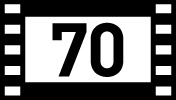

Interstellar, the latest mind-bending blockbuster from Christopher Nolan (Memento, Inception, the Dark Knight trilogy), is a futuristic epic grounded in old-school traditions of classic Hollywood family melodrama. Drawing heavily for inspiration on Stanley Kubrick’s immortal 2001: A Space Odyssey, as well as dozens of sci-fi films that followed it (Andrei Tarkovsky’s Solaris, Douglas Trumbull’s Silent Running, James Cameron’s The Abyss), Nolan attempts to find a fresh take on the inspirational space fable.
But while Interstellar shoots for the stars in terms of both entertainment and artistic value, it barely gets off the ground. Still, although I don’t think this highbrow epic can be viewed as anything more than an interesting failure, it's certainly the best picture yet from one of this generation's most overrated filmmakers, and I consider it well-worth seeing.
Interstellar takes place in a dystopic near future that strongly evokes the Dust Bowl of the 1930s. (Nolan even intersperses footage from interviews with actual Dust Bowl survivors, taken from Ken Burns’ recent PBS documentary series.) Matthew McConaughey plays Cooper, a former NASA pilot forced to turn to farming in the wake of an apocalyptic global crop blight. Coop's a widower, and a single father of two, and he struggles to support his family in an impoverished rural community somewhere in the American heartland.
Everything about the setting, tone, and attitudes is antiquated in this intentionally and unintentionally old-fashioned movie. Women are daughters, wives, and schoolteachers, and the only minorities are black men in ancillary or subservient roles (even if they have advanced degrees, they amount to little more than expendable crewmembers). The Earth of Interstellar is a red state American Earth; a world of rugged white men who drive trucks, work the land with a stoic sense of duty, and raise their kids according to their own rules, in defiance of the government's revisionist educational brainwashing. Nolan starts the film off on the wrong foot by presenting this throwback future as more Rockwellian than Orwellian. Twenty-five years ago, most of the movie-going public might have accepted this “idealized,” Field of Dreams America as representative of the universal human experience. But it’s difficult to envision contemporary audience members younger than forty connecting to this nostalgic imagery enough to make the movie fully resonate.
The scenery changes when Coop is tapped to lead a desperate deep-space quest to find a new planet for the human race to inhabit. He accepts, of course, hoping to save the lives of his children, even though it means leaving them behind on Earth. It's a great premise—exciting, original, and even scientifically plausible—but as Coop and his team (which consists of Anne Hathaway, David Gyasi, Wes Bentley, and two robots) prepare to embark on their mission, there’s almost no sense of wonder, fear, or uncertainty. Perhaps this is because Nolan, who wrote the film with his brother and frequent collaborator Jonathan, is notoriously bad at exposition. As with the Dark Knight films, The Prestige, and Memento, the Nolans try so hard to avoid the contrivances many screenwriters fall into when setting up a premise that they end up having to write absurd explanatory dialogue that sounds laughably unnatural when it comes out of their characters' mouths.
The concept and the conundrum are always more important in a Christopher Nolan movie than the story and the people who populate it. His films often feel like cold, cerebral puzzles, infused with schmaltzy, unearned emotional resonance. There are spiritual and mysterious elements to Interstellar, but the film is more interested in presenting easy answers to its sub-par riddles than in asking the fascinating existential questions that the science fiction genre is uniquely equipped to explore. I’m invariably disappointed when I get to the big reveal in a Nolan movie, because the answers he provides are at once too much and not enough. Rather than leaving things open, mystifying, and unanswerable, his complex narratives get reduced down to tidy conclusions that leave me asking, “Is that really what all this was about?”
Despite all these problems, McConaughey and the rest of the cast do a terrific job of selling Nolan’s hokum. Interstellar certainly qualifies as another powerful role in its star's mid-career upsurge, and it's especially stunning to compare this McConaughey with his younger self, who all but single-handedly ruined Robert Zemeckis’s 1997 sci-fi picture Contact. In that film, the lightweight pretty boy proved woefully dismissible as the Christian philosopher who was Jodie Foster’s romantic-interest-turned-spiritual-antagonist. If that same film were made today, there’s no question in my mind that McConaughey could supply the required depth, intelligence, and menace to the role. He brings the same level of commitment to Interstellar that he brought to Mud, Magic Mike, Killer Joe, The Paperboy, Dallas Buyers Club and the HBO series True Detective. Similarly, Jessica Chastain delivers the full weight of her commanding screen presence to the role of the grown-up Murph, the damaged but brilliant daughter Coop leaves behind on Earth. The movie is more than halfway over before we meet Murph as an adult, but Chastain manages to convey a great deal in her limited screen time.
Nolan is much better at casting actors than at writing characters. His frequent use of Michael Caine is the best example of this combination strength-and-shortcoming. Caine plays Professor Brand, a NASA scientist who conceives of the mission to save humanity. We don't get to know much about him, any more than we do about the Caine characters in other Nolan films, from Bruce Wayne’s trusted butler and father figure in the Dark Knight films, to the stage engineer and father figure to the rival magicians in The Prestige, to the mentor and father-in-law in Inception. The mere fact that Michael Caine is playing them tells us they are wise, paternal, and have been around long enough to know more than the main characters (or the audience) — but it would add tremendous depth to these films if Caine and Nolan’s other fine actors had more to work with.
There's just no getting around the fact that Murph, Brand, and all the other characters left back on Earth are little more than dismally underdeveloped personifications of ideologies or emotions. If the Nolans had the discipline to limit their story to the events that befall McConaughey, et al. in space, it wouldn’t matter that the characters on Earth are so one-dimensional; indeed, it would be entirely appropriate, since we'd only see them in the recorded video messages they send to the spaceship crew, and maybe in flashbacks. Filmmakers who work within narrative limitations fare immeasurably better than those who permit themselves unlimited freedom to do and show anything that comes to mind.
Nolan drew the wrong lessons from 2001: A Space Odyssey, as have so many other filmmakers who tried to duplicate, recreate, or top what Stanley Kubrick achieved with that groundbreaking picture. Like Steven Spielberg in Close Encounters of the Third Kind, James Cameron in The Abyss, Michael Bay in Armageddon, Ridley Scott in Prometheus, and Alfonso Cuarón in Gravity, Nolan appears to think that the major ingredient missing from 2001 is human connection. These filmmakers, who claim to draw inspiration from Kubrick, saturate their films with heartwarming and heartbreaking sequences—even though it is precisely the absence of human sentiment in 2001 that makes that film so effective and timeless. Kubrick’s film challenges audiences with unanswerable questions; Nolan’s film (like its predecessors) reassures audiences with easily relatable emotional concepts. Nearly all big budget space movies pale in comparison to Kubrick’s masterpiece because they shun stark, cerebral ambiguity in favor of warm, reassuring conclusions in which love, especially familial love, saves the day. As comforting as this theme might be, it doesn’t make for especially stimulating or thought-provoking drama. In the neo-Dust-Bowl future of Interstellar, corn is the only crop farmers can successfully harvest. Nolan’s movie suggests that it's also the only crop filmmakers can safely produce in our contemporary cinematic landscape.
But while Interstellar is maudlin, indulgent, and unfocused, and though it clocks in at nearly three hours, it's also exciting and visually impressive, and it never feels slow, boring, or overlong. Nolan makes his epic holiday blockbuster feel and look even more like an old-Hollywood “event” picture by shooting Interstellar on IMAX 70mm film, and by securing an advance release date for it in those theaters that still have the capacity to screen celluloid prints. It’s unfortunate that all this specialty handling is for a movie that doesn’t fully deliver on its potential, but watching the film on an enormous IMAX screen in a packed theater certainly adds a great deal to the viewing experience.
Though I’m not a fan of Nolan’s work and didn’t have high expectations for Interstellar, I waited to watch the movie until I was in a city where I could see it in its intended format—in this case, New York’s AMC Lincoln Center, which has a beautiful IMAX 70mm cinema. I enjoyed it enough to go see it again less than a week later at my local movie house (the Somerville Theater). My second Interstellar viewing was in 35mm, and by the time I saw it, the print had been screened four times a day for several weeks; scratches and imperfections were present and the film noticeably jumped around the projector’s gate. Though I didn’t like the movie enough to see it a third time in digital projection, the IMAX vs. 35mm comparison was interesting.
Nolan is one of the few major filmmakers working today who still eschews cinema's digital revolution. He shoots and finishes all his pictures on film, prefers to work on sets and practical locations rather than green-screen stages or motion-capture environments, and, whenever possible, prefers special effects done in-camera during principal photography over CGI in post-production. With Interstellar, Nolan takes this embrace of old-school photochemical filmmaking a step further by shooting the majority of the movie in IMAX.
I admire Nolan for stubbornly upholding the grand tradition of filmmaking on film, but I would be even more supportive if he made better movies. The outmoded feel of Interstellar’s themes and storytelling makes its technical production seem dated rather than purist. Like Paul Thomas Anderson, who shot The Master (2012) on 70mm film for its epic feel as much as to celebrate a dying format, Nolan doesn’t display a full mastery of the medium. Also like Anderson, Nolan doesn’t fully commit to his large-format process, shooting many sequences on traditional 35mm film because, he claims, some scenes don’t call for being shot in 70mm, or because it would be too difficult to get the big 70mm cameras into certain places. These justifications, upon which I’ve heard both Anderson and Nolan expand in interviews, make no sense to me. A director making a film in 70mm should shoot the entire film in 70mm. To not fully commit to the format makes its use play like a half-hearted stunt.
Nolan shot his last two Dark Knight pictures primarily in anamorphic 35mm but with several set pieces in IMAX, and the constant back-and-forth between formats with noticeably different film grains, depths of focus, and aspect ratios looked ridiculous. Interstellar has the inverse proportion of IMAX to 35mm shots, but it looks just as silly as The Dark Knight. I could understand shifts in presentation if there were an aesthetic rationale behind them—Earthbound shots in 35mm; space shots in 70mm, for example—but, alas, I can't discern any thematic or narrative motivation. Sometimes entire scenes and sequences photographed in IMAX have just one or two cuts to a 35mm shot, requiring a jarring letterboxing of the giant IMAX screen.
When seeing The Dark Knight in an IMAX theater, this technique looks like a gimmick to make the action sequences seem more thrilling. But in Interstellar it gives the impression of a mistake, or of watching a rough-cut with temporary shots spliced in until the final IMAX negative becomes available. Of course, when viewing the film in standard (non-IMAX) theaters, the shift in grain and depth is much less conspicuous, and the aspect ratio is a consistent 2.35:1. But this traditional widescreen presentation crops the top and bottom of the IMAX images, to the point of compromising many of the compositions. Again, I ask with bewilderment: why shoot the majority of your film in the almost-square 1.33:1 ratio if you’re just going to crop most prints to 2.35:1? Maybe I’m being overly technical and nitpicky, but it seems inconsistent to me for a filmmaker to be so passionately devoted to celluloid over digital when he doesn't seem to care about staying true to the cinematic format he is working in.







